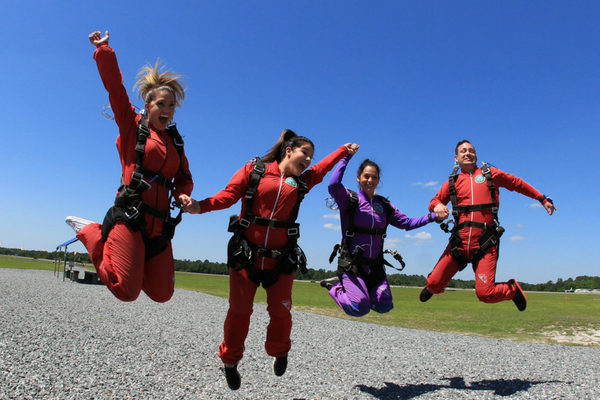5 Strategies For Facing Your Fear Of Heights
Saturday, May 5, 2018
Do you have an extreme fear of heights, but want to go skydiving? We’d like to suggest that your fear of heights doesn’t have to stop you. Here are 5 tips to help you get over your fear of heights and experience the exhilaration of skydiving!
If stepping up or stepping out grips you in fear, you’re in good company. Among the most common sources of anxiety, acrophobia – or the fear of heights – causes millions of people to opt out of a variety of activities, from simple tasks like climbing on a chair to awe-inspiring experiences like scaling a mountain. For those who can’t relate, I wouldn’t be too quick to pat yourself on the back. Being free of acrophobia isn’t necessarily ideal. Remember the old adage, “An ounce of prevention is better than a pound of cure”? Turns out, there’s something to that …
LET’S ZOOM IN A LITTLE
The term “acrophobia” comes from the Greeks – acron = peak, summit or edge, phobos = fear. The ancients needed a label for the fear because it was common then, too. Turns out, it’s innate in mammals. Even babies can be observed demonstrating fear or discomfort when up high. Having a rational fear of heights can be key to survival – saving you from getting too close to the literal edge. The butterflies, the clammy hands, the involuntary expletives; we are evolutionarily predisposed to setting off physical, emotional and even vocal alarm bells. Self-diagnosed thrill seekers get a kick out of this surge of triggered energy and can often be found at theme parks and climbing up, or jumping off, a host of things.
But there’s an irrational fear of heights that can be debilitating. Keeping people – twice as often women than men – from doing what most of us would consider ordinary or mundane activities. The irrational version has people fearful of driving across bridges, using stepladders, walking near upstairs windows, as examples. And worse, even the anticipation of being up high or the sight of a high place can induce panic. Extreme fear of heights can be learned through trauma or, some suggest, it may be hereditary. It’s also known to increase with age.

ACROPHOBIA IN ACTION
An acrophobic’s fear can manifest in a variety of ways, many of which are observable and some of which are internal.
Emotional distress includes a sense of panic and dread due to the perception of being elevated, the need to search for something to cling to for balance, the compulsion to kneel, get down on all-fours or crawl. (In other words, everything in you says, “SERIOUSLY, GET DOWN!”)
Physical symptoms include sweating, shaking, crying, shouting, heart palpitations, stomach cramps and nausea, dizziness, shortness of breath or rapid breathing, and vertigo.
As common as it is, most everyone knows someone who struggles with some version of acrophobia. If you are the one struggling, talk with your friends and family and let them know what signs to look for and give them ideas for ways to support you in the moment.

GROUNDING YOUR FEAR
Like most phobias, given time and dedication, acrophobia is treatable. Therapy and medication are well-known options, and there a number of other attainable ways to temper the fear. Here are five tips to carry with you:
1. Attainable Goals.
Thankfully, people are no longer literally thrown in the deep end to teach them to swim. In the same way that swimming proficiency increases with practice, acrophobes can begin to ground their fear by setting attainable goals. What is achievable is determined by the person struggling with the fear; everyone is different. For one, it may be inching closer to a window day-by-day, for another it may be watching online videos of people doing particularly what they fear.
Consider making a list of goals that feel realistic and, when you’re ready, give it a go.
2. Be Kind to Yourself
Overcoming any fear takes work. Everyone’s journey is different; remember to be kind to yourself along the way. Recognize your victories, no matter how small, and care after yourself in the same way you would someone dear to you. Punishing yourself for slow progress is short-sighted; forward momentum should not be taken for granted.
Consider recording your progress in a way that is meaningful to you – keep a journal, take selfies or video of how you feel as you accomplish goals, chart your progress on a calendar – and always remember to keep it positive.
3. Collect Your Thoughts
Spending time in thought about what scares you can help you get in the right headspace to face it. Thinking through the details can cause you to identify the particular aspects of an experience that are causing anxiety. Isolating “the what” empowers you to ask relevant and intelligent questions and makes the process of setting attainable goals to overcome pain-points a whole lot easier.

If you’re planning to go tandem skydiving, for example, think about how you’ll get to the dropzone and who might be with you … remember you’ll have some training and find comfort knowing that your instructors have extensive training … think about what the plane might sound like, etc. What excites you? What is worrying you? How can you resolve it?[AT1]
4. Deep Breaths.
Depriving your brain of oxygen is a sure-fire way of putting anxiety into overdrive. Forgetting to breathe is hyper-common in perilous situations. Making a conscious effort to take deep breaths – in through your nose, out through your mouth – will help maintain oxygen supply and, in turn, keep an acrophobe’s rational brain closer to the driver’s seat.
Practice breathing often so you trust your ability to do it and see the benefit to its calming effect. If you find yourself overthinking it, consider breathing while you silently count – inhale on 1, exhale on 2 – and when you get to the count of 10, start again at 1.
5. Envision Success
Reveling in victory feels GREAT. Visualizing yourself on the other side of a daunting experience can be exhilarating to the point that it provides fuel for the voyage. Affirming it can be done is incredibly powerful and can give the body and brain permission to go forth and conquer.

Close your eyes and envision the experience in detail. What’s helping you feel safe? Who’s cheering you on as you complete the task? What does it feel like to GET IT DONE? Consider taking a mantra with you to help you focus – perhaps, “I am safe, I am strong, I am successful” – you decide what’s right for you.
So, little-known fact: the opposite of having a fear of heights is called having a head for heights. Practicing these 5 tips (A, B, C, D, E – see what I did there?), might be just what you need to step out.
If you’re ready to learn more about the tandem skydive experience, spend some time with the requirements and get in touch! We’re ready to help you take the leap.
—
[AT1]Trying to give some comfort in case some acrophobes read this! Might feel forced, and it may be incorrect. Needs some love, most likely.







